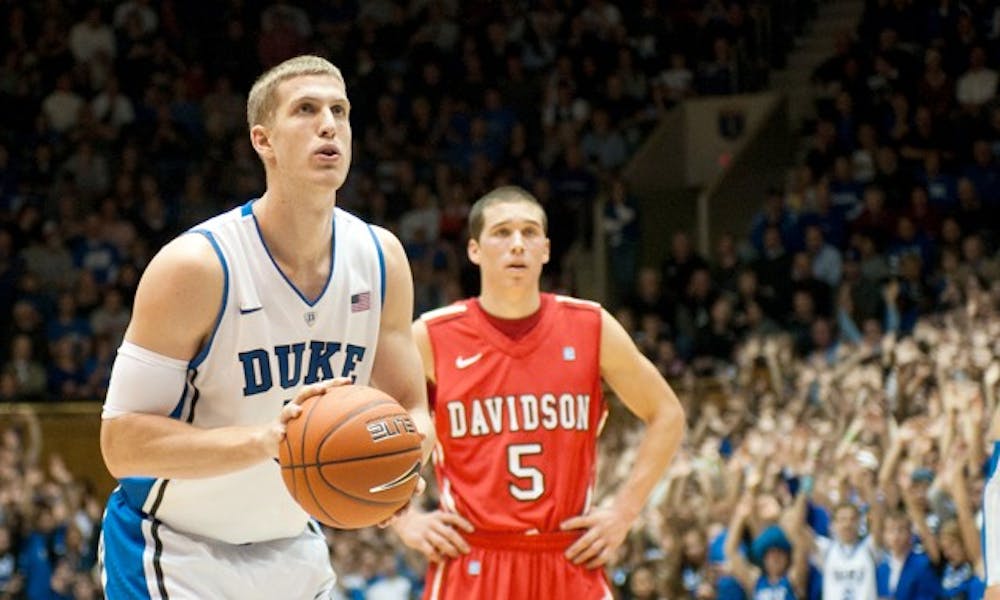Oh, the foul shot. That elusive, undefended moment of bliss when a player is awarded between one and three attempts to make an open shot from a line drawn 15 feet from the basket.
Evidently, though, making a free throw is harder than it looks. Duke has been historically poor from the foul line this season, making only 68.5 percent of its attempts. While this ranks in a tie for 174th nationally and could be considered average on a national scale, the Blue Devils have shot above 70 percent from the line 12 of the past 16 seasons and have been above 75 percent in each of the past two.
Duke has already seen two of the league’s top-five defensive teams in Georgia Tech and Virginia, and escaped defeat in each case despite very different performances at the line. Against the likes of defensive stalwarts with more polished offensive weapons, such as Florida State and North Carolina, Duke will need to be able to rely on its free throw shooting late in games—as it did against Georgia Tech—to pull out victories over the top contenders in the conference.
The 68.5-percent output is Duke’s lowest since 1995, which, interestingly enough, was the first time that Jeff Capel, Chris Collins and Steve Wojciechowski sat together on the Blue Devils’ bench as players. Before that, the last time Duke was this poor from the line was 1965—well before the Mike Krzyzewski Era.
Yet for Duke this season, the shooting woes at the foul line have not been a team-wide phenomenon. Ryan Kelly hit 14-of-14 down the stretch at Georgia Tech, and Seth Curry shoots a gleaming 89.1 percent from the charity stripe.
Unfortunately, while Kelly ranks second on the team in free throw attempts with 88, Curry is a distant fourth with only 55. First and third? Mason Plumlee and Austin Rivers, who manage to squeeze in 42.3 and 67.5 percent of their attempts, respectively, on at least 80 shots apiece. Plumlee’s woes have been well noticed by the crowds at Cameron Indoor Stadium, eliciting jubilant cheers of relief when two of his 10 attempts fell Thursday night against the Cavaliers.
Alas, the contest at Clemson was only the fourth time this season that Plumlee has been above 50 percent for a single game, and he has hit exactly half on another three occasions. By comparison, the last NBA-caliber big man to play regularly in Cameron, Sheldon Williams, was only below 50 percent from the line in a single game twice as a senior.
Plumlee is especially frustrating to watch because of the discrepancy between his performance at the line at home and his production from the stripe away from Cameron. In the past five games, the Blue Devils have played in Cameron twice and on the road three times. In the two games on campus, Plumlee has shot a dismal 4-for-15 from the line. Away? A perfect 9-for-9.
For Rivers, the poor shooting has been less of a glaring deficiency, but his conversion rate at the line has been consistently below the average of Duke’s guards. For the Blue Devils’ top perimeter scoring threat production at the free throw line could—and should—be an integral complement to the rest of Rivers’ game. Although his scoring output has dropped over recent weeks mainly as a result of a plummeting field goal percentage, Rivers could buoy that scoring drought with more free throw conversions.
The Dick Vitales and Jimmy Dykes of the world always talk about how scorers need to see the ball go through the hoop to gain confidence and catch a hot streak. What better way to gain that confidence than at the line, undefended, with the clock stopped?
Poor foul shooting has yet to truly cost Duke a game this season, but an 8-for-19 performance in a three-point victory over Virginia was awfully close. The Blue Devils are second in the ACC in free throw attempts, which helps to offset the subpar percentage at the line. Perhaps the more worrisome figure for Duke is its opponents’ field goal percentage, which puts the Blue Devils’ defense dead last in the conference. As Duke begins to play against stronger teams that can limit its opportunities on the perimeter while also executing offensively—call it the Temple model—the Blue Devils will find themselves in close games where free throws will make all the difference.
Get The Chronicle straight to your inbox
Signup for our weekly newsletter. Cancel at any time.

